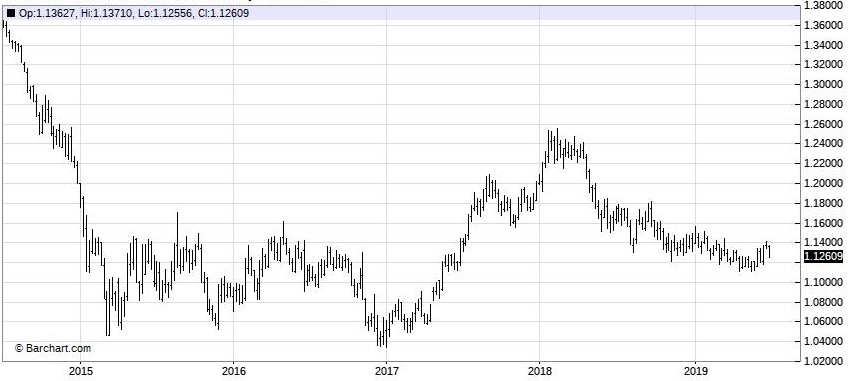Global trade & geo-political tensions have been steadily rising this year. For example the US-China trade war (& broader power struggle behind this), US-Iran tensions and Brexit. In parallel, the monetary policy measures of central banks are becoming increasingly unconventional and aggressive (e.g. negative interest rates & structural quantitative easing).
These dynamics are likely to play out in the form of rising currency volatility or even larger scale currency shocks. In this environment it is a good time to consider the impact of FX movements on energy prices.
The EUR-USD relationship is key
The primary driver of currency movements impacting European energy markets is the EUR-USD FX market. This is the world’s most liquid market with in excess of 1 trillion USD daily transaction flow.
Global commodity markets such as oil and coal are traded in USD terms. So if the EUR falls against the USD, commodity costs rise in EUR terms. This has a direct impact on assets exposed to oil, liquids & coal prices. Chart 1 provides some context on the evolution of the EUR-USD exchange rate.
Interest rate, inflation & economic growth differentials between the US & Europe play an important role in driving EUR-USD levels. The EUR has fallen against the USD since the start of 2018, as interest rates & growth in Europe have been lower than in the US. But the EUR has stabilised in 2019 as US growth has slowed and financial markets have priced in US rate cuts across H2 2019 (Eurozone rates are already negative).
European gas prices & FX movements
The impact of FX movements on European gas prices is more complicated. European gas prices are driven by the TTF hub and essentially priced in EUR terms based on the prevailing supply & demand balance across Europe’s interconnected hub network.
While European gas is priced in EUR terms, coal to gas switching levels are an important marginal driver of hub prices. This creates an implicit USD linkage via the variable cost of coal plants. If the EUR rises against the USD, it reduces the variable cost of coal plants, putting downward pressure on relative switching levels and TTF.
LNG spot prices & FX movements
The impact of currency movements on LNG prices is also more dynamic. LNG is traded in USD terms. But European gas hub prices underpin LNG spot pricing dynamics. So even though cargos change hands in USD, it is TTF (a EUR based market) that is the global spot price benchmark.
If for example the EUR appreciates against the USD, the TTF price level typically rises in USD terms (as can be seen via TTF futures contracts transacted in USD/mmbtu). That in turn can pull up Asian spot price levels which are typically traded on a ‘variable cost plus’ basis to TTF.
There is also a further currency driver that is important to consider given current oversupplied conditions in the LNG market. TTF prices have been driven down towards US Henry Hub ‘shut in’ levels by surplus volumes of LNG flowing into Europe. So TTF is currently effectively trading on a ‘variable cost plus’ basis to Henry Hub.
The current role of Henry Hub as a global spot price floor therefore introduces a USD price linkage to both European hubs and Asian LNG spot prices.

